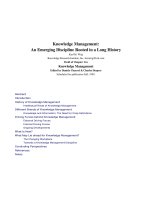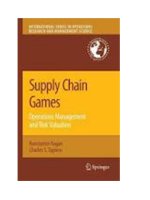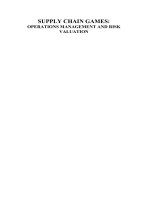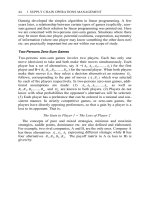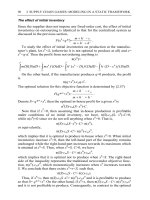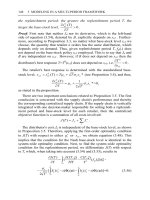Supply chain risk management An emerging discipline
Bạn đang xem bản rút gọn của tài liệu. Xem và tải ngay bản đầy đủ của tài liệu tại đây (3.22 MB, 328 trang )
Series on Resource Management
Supply Chain Risk
Management
An Emerging Discipline
Gregory L. Schlegel
Robert J. Trent
Supply Chain Risk
Management
An Emerging Discipline
Supply Chain Risk
Management
An Emerging Discipline
Gregory L. Schlegel
Robert J. Trent
CRC Press
Taylor & Francis Group
6000 Broken Sound Parkway NW, Suite 300
Boca Raton, FL 33487-2742
© 2015 by Taylor & Francis Group, LLC
CRC Press is an imprint of Taylor & Francis Group, an Informa business
No claim to original U.S. Government works
Version Date: 20140821
International Standard Book Number-13: 978-1-4822-0599-2 (eBook - PDF)
This book contains information obtained from authentic and highly regarded sources. Reasonable
efforts have been made to publish reliable data and information, but the author and publisher cannot
assume responsibility for the validity of all materials or the consequences of their use. The authors and
publishers have attempted to trace the copyright holders of all material reproduced in this publication
and apologize to copyright holders if permission to publish in this form has not been obtained. If any
copyright material has not been acknowledged please write and let us know so we may rectify in any
future reprint.
Except as permitted under U.S. Copyright Law, no part of this book may be reprinted, reproduced,
transmitted, or utilized in any form by any electronic, mechanical, or other means, now known or
hereafter invented, including photocopying, microfilming, and recording, or in any information storage or retrieval system, without written permission from the publishers.
For permission to photocopy or use material electronically from this work, please access www.copyright.com ( or contact the Copyright Clearance Center, Inc. (CCC), 222
Rosewood Drive, Danvers, MA 01923, 978-750-8400. CCC is a not-for-profit organization that provides licenses and registration for a variety of users. For organizations that have been granted a photocopy license by the CCC, a separate system of payment has been arranged.
Trademark Notice: Product or corporate names may be trademarks or registered trademarks, and are
used only for identification and explanation without intent to infringe.
Visit the Taylor & Francis Web site at
and the CRC Press Web site at
Contents
Preface.................................................................................................. xiii
About the Authors................................................................................xix
Chapter 1 Supply Chain Risk Management: Setting the Stage.......... 1
The Concept of Risk and Risk Management............................2
Defining Enterprise Risk Management................................3
Defining Supply Chain Risk Management..........................6
Why Focus on Supply Chain Risk Management?....................7
Some SCRM Observations...................................................10
Why Aren’t We Prepared for SCRM?.................................10
Some Important Risk Concepts...............................................11
Risk Event...............................................................................11
Risk Exposure and Vulnerability........................................12
Risk Resilience.......................................................................13
Risk Appetite..........................................................................14
Risk Analysis or Assessment................................................15
Risk Response Plan................................................................15
Risk Compliance....................................................................15
Risk Governance....................................................................16
Categorizing Risk.......................................................................16
Other Ways to Look at Risk.................................................17
Generic Risk Management Approaches..................................18
Risk Mitigation......................................................................18
Risk Avoidance.......................................................................19
Risk Prevention......................................................................19
Risk Acceptance.................................................................... 20
Risk Sharing.......................................................................... 20
Prevention versus Responsiveness.......................................21
Concluding Thoughts................................................................21
Summary of Key Points........................................................21
Endnotes......................................................................................22
v
vi • Contents
Chapter 2 Supply Chain Risk Management: The As-Is Landscape.... 25
A Chronology of Supply Chain Risk Management...............25
2009.........................................................................................26
2010..........................................................................................27
2011......................................................................................... 30
2012..........................................................................................32
2013......................................................................................... 34
Four Pillars of Supply Chain Risk Management....................36
Supply Risk.............................................................................37
Process Risk............................................................................37
Demand Risk..........................................................................37
Environmental Risk..............................................................37
The Supply Chain Risk Management Adoption....................39
SCRM Adoption................................................................... 40
Concluding Thoughts................................................................41
Summary of Key Points....................................................... 42
Endnotes..................................................................................... 43
Chapter 3 Building the Risk Management Foundation................... 45
Supply Chain Risk Management Enablers..............................45
A Supportive Organizational Design................................. 46
Information Technology.......................................................51
Measurement Systems...........................................................53
Talent Management.............................................................. 54
Linking Supply Chain Risk Management and Supply
Chain Strategy........................................................................... 56
Integrating Risk Management with Commodity
Strategy Development...........................................................57
The Ultimate Risk—Improve or Else!......................................59
Rallying around a Superordinate Measure....................... 60
Reducing Supply Risk through a New Approach to
Contracting............................................................................61
Systems Contracting Benefits..............................................62
Concluding Thoughts................................................................63
Summary of Key Chapter Points........................................ 64
Endnotes......................................................................................65
Contents • vii
Chapter 4 Strategic Risk..................................................................... 67
What Is Strategic Risk?............................................................. 68
Reducing Strategic Risk through Better Product
Development...............................................................................69
New Product Development Best Practices.........................69
Bringing New Product Development and Risk
Management Together..........................................................73
The Art and Science of Not Getting Caught by Surprise......74
Protecting Intellectual Property...............................................79
When Strategic Risk Becomes Strategic Reality....................82
Concluding Thoughts............................................................... 84
Summary of Key Points........................................................85
Endnotes..................................................................................... 86
Chapter 5 Hazard Risk....................................................................... 87
The Traditional World of Hazard Risk and Insurance.........87
First-Party Commercial Property Insurance....................89
Cargo Insurance................................................................... 90
Cyber Insurance.................................................................... 90
Business Interruption Insurance........................................ 90
Contingent Business Interruption Insurance....................91
Trade Disruption Insurance.................................................91
Global Logistics Insurance...................................................92
Quantifying Traditional Hazard Risk Insurance
Requirements..............................................................................94
Looking at the Thai Floods through a Risk
Quantification Prism.............................................................. 100
Concluding Thoughts..............................................................101
Summary of Key Points......................................................102
Endnotes....................................................................................102
Chapter 6 Financial Risk.................................................................. 103
Understanding Financial Risk................................................104
Supplier and Customer Financial Viability.....................104
Supply Market Volatility.....................................................105
A Case Study of Supply Market Volatility........................106
viii • Contents
Getting Serious about Managing Financial Risk.................107
Supplier Financial Health Assessment through
Ratio Analysis......................................................................108
Bankruptcy Predictors........................................................111
Private Company............................................................112
Public Company..............................................................112
Qualitative Supplier Financial Risk Indicators...............115
Assessment of Customer Creditworthiness.....................116
Hedging.................................................................................118
Currency Risk Management Approaches....................... 120
Concluding Thoughts............................................................. 123
Summary of Key Points..................................................... 124
Endnotes................................................................................... 124
Chapter 7 Operational Risk............................................................. 127
Operational Risks.....................................................................127
Supply Risk.......................................................................... 128
Demand Risk........................................................................131
Process Risk......................................................................... 134
Environment/Ecosystems Risk..........................................137
Business Continuity Planning................................................139
Business Continuity Planning Objective..............................140
The Business Continuity Life Cycle..................................141
BCP Exercises.......................................................................144
Concluding Thoughts..............................................................145
Summary of Key Points......................................................145
Endnotes....................................................................................146
Chapter 8 Supply Chain Fraud, Corruption, Counterfeiting,
and Theft......................................................................... 147
Some Key Concepts..................................................................148
Bribery...................................................................................148
Counterfeiting......................................................................149
Fraudulent, Corrupt, Coercive, and Collusive Practices....150
Rules and Regulations.............................................................153
Consumer Financial Protection Bureau (CFPB).............153
Customs Trade Partnership against Terrorism
(C-TPAT).............................................................................. 154
Contents • ix
Dodd-Frank Wall Street Reform and Consumer
Protection Act......................................................................155
Foreign Corrupt Practices Act...........................................155
Tools, Best-in-Class Practices, and Countermeasures........156
Fraud, Corruption, and Theft Tools..................................156
Supplier Co-Management..................................................158
Addressing Corruption with Best Practices....................159
Counterfeit Countermeasures...........................................161
Concluding Thoughts..............................................................162
Summary of Key Points......................................................163
Endnotes....................................................................................163
Chapter 9 Emerging Risk Management Frameworks for Success.... 165
What Is a Framework?.............................................................165
Frameworks Supporting the New Supply Chain Risk
Management Discipline...........................................................166
Enterprise Risk Management (ERM) Framework..........166
COSO ERM Framework.....................................................167
ISO Standards......................................................................168
Governance, Risk, and Compliance (GRC).....................172
Risk Taxonomies—An Operational Framework For
SCRM.........................................................................................175
Leveraging ERM, GRC, and Risk Taxonomies....................177
Benefits of ERM and GRC Frameworks................................180
Concluding Thoughts..............................................................183
Summary of Key Points......................................................183
Endnotes....................................................................................184
Chapter 10 Using Probabilistic Models to Understand Risk........... 185
Defining the Models................................................................185
Probabilistic versus Deterministic Modeling Tools............187
Risk Response Plans.................................................................191
Company Examples of Probabilistic Modeling...................192
Scenario Planning at DuPont............................................192
Stress Testing the Supply Chain at Bayer Material
Sciences.................................................................................194
Next-Generation S&OP at Huntsman..............................197
x • Contents
Concluding Thoughts............................................................. 200
Summary of Key Points..................................................... 200
Endnotes....................................................................................201
Chapter 11 Using Big Data and Analytics to Manage Risk............. 203
What Is Big Data and Predictive Analytics, Really?.......... 204
The Process of Successfully Leveraging Big Data for
Maximum Benefit.................................................................... 207
Barriers and Challenges Moving Forward........................... 209
Tools, Techniques, and Methodologies Supporting Big
Data............................................................................................210
How Early Adopter Companies Leverage Big Data.............213
Consumer Packaged Goods...............................................214
Dell Computers....................................................................214
Western Digital....................................................................215
Harley Davidson..................................................................215
Raytheon...............................................................................216
European Electrical Utility................................................216
Schneider..............................................................................217
Concluding Thoughts..............................................................218
Summary of Key Points......................................................219
Endnotes....................................................................................219
Chapter 12 Emerging Risk Management Tools, Techniques, and
Approaches...................................................................... 221
Become a Preferred Customer................................................221
Gaining Preferred Customer Status................................. 223
Construct Supply Chain Heat Maps..................................... 225
Map the Supply Chain............................................................ 226
Challenges When Mapping a Supply Chain................... 226
Supply Chain Mapping Guidelines.................................. 227
Decluster the Clusters............................................................. 229
Clustering Gone Wild........................................................ 230
Create a Flexible Supply Chain...............................................231
Examples of Flexibility........................................................232
Create a Risk War Room.........................................................237
Contents • xi
Manage Working Capital....................................................... 238
Controlling Inventory through Perfect Record
Integrity................................................................................239
Effective Demand Estimation and Management........... 240
Concluding Thoughts............................................................. 242
Summary of Key Chapter Points...................................... 242
Endnotes................................................................................... 243
Chapter 13 Risk Measurement........................................................... 245
Risk Measurement Validity and Reliability......................... 245
Validity and Bridge Safety Measures............................... 247
Supplier Performance Measurement—Doing It Right....... 248
Quantified Risk Indexes......................................................... 250
A Risk Index Example.........................................................251
Country Risk Indexes.........................................................251
Using Total Cost Measures to Manage Risk.........................252
Types of Total Cost Models................................................253
Supplier Capacity Estimate Measures.................................. 258
Emerging Supply Chain Risk Metrics.................................. 260
Value at Risk........................................................................ 260
Time-to-Recovery............................................................... 260
Risk Exposure Index...........................................................261
Supply Chain Key Performance Indicators......................261
Concluding Thoughts............................................................. 264
Summary of Key Points..................................................... 264
Endnotes................................................................................... 265
Chapter 14 Learning from Risk Management Leaders.................... 267
Making Risk Management a Priority at Boston
Scientific.................................................................................... 267
Having the Right Tools...................................................... 268
Navigating Threats at Boeing................................................. 269
Supplier Risk Assessment at IBM...........................................271
IBM’s Risk Management Tool............................................272
Using Supply Chain Mapping to Manage Risk at Cisco.....274
Surviving a Near-Death Experience at Delphi.....................275
xii • Contents
Managing Strategic Risk through Collaborative Cost
Management..............................................................................276
A Collaborative Approach to Cost Management........... 277
Learning about Risk the Hard Way at J. C. Penney.............279
Concluding Thoughts............................................................. 280
Endnotes....................................................................................281
Chapter 15 Future Directions in Supply Chain Risk Management.... 283
Supply Chain Risk Management Predictions...................... 283
An Evolving Risk Management Maturity Model................291
Supply Chain Risk Maturity Model................................. 292
Visibility............................................................................... 292
Predictability........................................................................293
Resiliency..............................................................................293
Sustainability....................................................................... 294
A Call to Action....................................................................... 294
Establish the Risk Leadership Team................................ 294
Establish Risk Crisis Teams...............................................295
Focus on the Risk-Management Enablers....................... 296
Assess the Current State of Risk Management
Preparedness....................................................................... 296
Perform Risk Assessments and Develop Risk
Management and Business Continuity Plans................. 297
Gain Visibility across the Supply Chain.......................... 297
Benchmark Risk Management Practices against
Industry Leaders................................................................. 298
Develop or Obtain the Tools, Techniques, and Risk
Protocols.............................................................................. 298
Concluding Thoughts............................................................. 298
Endnotes................................................................................... 299
Appendix: The Supply Chain Risk Assessment Tool........................ 301
How You Might Utilize the Tool............................................301
Walking through the Questions-of-Discovery................... 303
How to Access the Tool.......................................................... 303
Preface
Perhaps the best way to introduce a book about supply chain risk management (SCRM) is to start with some real although not necessarily uplifting
stories. Each of the following occurred in the same week and year during a
December holiday season. The names of the companies involved have not
been changed to protect the innocent.
Guaranteed On-Time Delivery, Except When It’s Not. In its end-of-
year edition, Business Week magazine prominently featured a cover story
about how UPS was going to save Christmas. The magazine chronicled the
efforts of the man responsible for making sure all those packages ordered
just before Christmas would make their way under the tree in time.
Retailers such as Amazon guaranteed that orders placed by December 23
would arrive in time for the big day. This was going to be a defining
moment for supply chain managers and online retailers! A convergence of
events, however, ensured that Scrooge would have the final say.
What actually happened is a perfect storm that will be studied for
many years. While big shippers like Amazon claimed their innocence by
announcing that its shipments were given to UPS on time (failures from
risk events almost always feature blaming someone else), not enough
planes at UPS were available to move such a large number of packages,
creating huge bottlenecks.
So, what happened? More consumers than forecast shopped online
that holiday season, creating higher-than-anticipated demand. And, only
26 days separated Thanksgiving and Christmas, compared with 32 days
the previous year. A great deal of shopping was crammed into fewer shopping days. It did not help that bad weather across much of the United States
during this period interrupted package delivery service. Bad weather had
a secondary effect of keeping consumers inside where they proceeded to
do to even more online shopping. And not surprisingly, many consumers
waited until the last minute to place their orders. Why not wait? Retailers
such as Amazon guaranteed delivery even though UPS has some fine
print stating that delivery is not guaranteed during peak holiday periods.
Unfortunately, UPS took a substantial hit to its earnings and reputation.
When Swiping Means Getting Swiped. Target Corp. announced that
40 million customer credit cards were in jeopardy because of a security
xiii
xiv • Preface
breach at its point-of-sale store registers. A few days later Target admitted
that personal data for up to 70 million customers was also compromised.
The retailer told customers they should examine transactions made on
their credit and debit cards during a 19-day period and report any fraudulent sales. Making matters worse, credit and debit card accounts stolen
during this period reportedly flooded underground black markets, going
on sale in batches of one million cards. A fraud analyst at a major bank
said his team purchased a portion of the customer accounts from an
online store advertised in cybercrime forums. The reporting of this security breach coincided with a subsequent drop in Target’s sales, likely due
to a loss in customer confidence.
Shortly after the security breach Target, executives announced a set of
actions that cost some serious money
Target closed the access point that the criminals used and removed the
malware they left behind; hired a team of security experts to investigate
the security breach; communicated that its customers would have zero liability for any fraudulent charges arising from the breach; and offered one
year of free credit monitoring and identify theft protection to all customers. It’s no fun getting swiped.
Heavy Metal Hoarders. A report in The Wall Street Journal revealed
that banks, hedge funds, commodity merchants, and other investors were
hoarding tens of millions of tons of aluminum, copper, nickel, and zinc in
a system of hidden warehouses around the world. So what’s the big deal?
Once hidden in these warehouses, these metals are no longer tracked, making accurate calculations of market supply, something that is needed to
determine commodity prices, next to impossible to determine. Producers
are bracing for wild swings in metals’ prices as speculators withhold data
to take advantage of pricing volatility. Market manipulation is likely as
metals are controlled by fewer and fewer hands whose interests are likely
not aligned with legitimate commodity users.1
Toss This Example. In an unfortunate case of how the Internet and
social media can place a company’s reputation at risk in the blink of an
eye, a home security video system captured a FedEx driver tossing a package onto a customer’s porch. This might have remained a local event except
for the fact that millions of people watched the uploaded video as it went
viral. Judging from the driver’s throwing technique he is likely the star of
his Frisbee golf team.
Welcome to the world of supply chain risk management. It is a world
where the end of your day might not be nearly as good as the start of your
Preface • xv
day. While the examples presented here caused problems at many levels,
and we do not want to diminish the harm that came to innocent bystanders,
they illustrate that what can happen in a typical week is not always all that
typical. As we will discuss, the supply chain world is becoming riskier rather
than safer. A survey used to calculate the Allianz Risk Barometer recently
concluded for the first time that supply chain risk is now the top concern of
global insurance providers. This reinforces our belief that a book about supply chain risk management is relevant and timely. So, how was your week?
SUPPLY CHAIN RISK MANAGEMENT THEMES
As we progress through this book, certain themes are revealed that underlie our view of supply chain risk management. These themes support the
basis for everything we present.
• The financial impact of supply chain disruptions can be deva
stating but is often not understood until it is too late. Studies
show that, on average, if a publicly held company experiences a
moderate or higher risk event, it can expect a 7%–10% reduction
in shareholder value. And, approximately 30% of companies that
experience a major risk event are out of business within 24 months
of the event, and another 25% are out of business after three years.
• The supply chain management profession has become too comfortable with the deterministic models and tools developed over the
last 35 years. The relatively stable environment of the last 35 years
is no longer in existence, and deterministic tools such as forecasting
models and sales and operations planning (S&OP) processes have
never taken uncertainty into account. Unfortunately, global supply
chain growth has resulted in uncertainty, complexity, and risk growing in frequency and severity. The time has come to utilize probabilistic tools that take into account uncertainty in order to manage risk.
• SCRM is an evolving discipline and will remain so for the foreseeable future. To be successful in a new global environment, becoming
a risk management leader demands mastering four stages of SCRM
excellence: visibility, predictability, resiliency, and sustainability.
These are part of something we call the 21st Century Supply Chain
Risk Maturity Model.
xvi • Preface
• Supply chain strategies driven primarily by cost management
and delivery improvements are no longer comprehensive enough.
The time has come to make supply chain risk assessments part of the
supply chain planning process. Today these risk assessments are still
unfortunately more of an afterthought.
• Showing a hard return on investment for risk management initiatives is a difficult sell. How do you justify an investment for managing something as vague as a potential risk event? Our view is that
traditional financial models are proving to be inadequate when evaluating risk management investments.
• Social media is the new risk wild card. A brand built over 50 years
can come under attack with a tweet (regardless of whether the tweet
is true or not). A negative video on YouTube can go viral in minutes.
Social media can amplify the outcome from risk events that may
have previously been localized.
• The risk ledger has two sides. One side of the risk ledger is the negative side of risk. The other side of the ledger, however, represents
opportunity management. It is the upside of risk, as someone’s risk
is often another’s opportunity. Our focus, while recognizing both
sides of this ledger, will stress the downside of risk.
• Supply chain risk is making it to the big leagues. Companies are
placing supply chain risk management verbiage in their 10K and
annual reports, something that was rare not too long ago. This illustrates how seriously supply chain risk is being taken at the corporate level. Unfortunately, it also shows how serious the impact can be
from supply chain disruptions.
• Risk heroics must give way to risk prevention wherever possible.
Interviews with leading executives lead us to a clear conclusion.
Most companies are tired of responding, sometimes heroically,
when a risk event occurs. Increasingly these companies would like to
model, anticipate, and even prevent risk events from occurring. The
pendulum needs to shift from heroic responsiveness to proactive risk
prevention wherever possible. Constantly running around with your
hair on fire gets tiring.
• We need to take a broader rather than narrower view of supply
chain risk management. As a concept, SCRM is similar to Lean
and Six Sigma. A narrow view of these concepts considers them
mainly as a set of tools and techniques. The broader view, and the
one endorsed throughput this book, is that SCRM, like Lean and Six
Preface • xvii
Sigma, is supply chain–wide, affects an organization’s culture, and
can have a positive or negative strategic impact.
• Supply chain risk is increasing, not decreasing. With globalization expanding at a remarkable rate over the last 20 years, supply
chains have moved into areas where they’ve never operated. Thus,
uncertainty, complexity, and risk have grown exponentially. If anyone claims that supply chain risk is decreasing in terms of impact
and concern, ask to see their evidence. We will show an abundance
of evidence to indicate the contrary.
ORGANIZATION OF THIS BOOK
This book is organized into four sections. The first section sets the stage
by positioning our understanding of supply chain risk management.
Chapter 1 explains the important concepts and terminology that appear
throughout this book. The second chapter provides an overview of the
“as is” state of SCRM, an overview that reveals that while most managers appreciate the importance and danger of risk, few organizations are
prepared for this new environment. Chapter 3 recognizes that achieving
excellence in any area, including risk management, does not happen simply
because a company announces its desire for excellence. It also highlights a
set of enablers that provide the foundation for effective risk management.
The second section of this book presents a traditional but still important
view of SCRM. Here, we address strategic risk (Chapter 4), hazard risk
(Chapter 5), financial risk (Chapter 6), and operational risk (Chapter 7).
These chapters will describe many approaches for addressing risk within
these four categories.
Section III dives into the emerging discipline called supply chain risk
management. Chapter 8 addresses fraud, corruption, theft, and counterfeiting; while Chapter 9 presents a set of emerging risk management
frameworks. This is followed by two leading-edge topics—using probabilistic models to understand risk (Chapter 10), and using analytics to predict the future (Chapter 11). Chapter 12 presents an emerging set of risk
management tools, techniques, and approaches that are broader than what
we typically associate currently with risk management. The important
topic of risk measurement appears in Chapter 13, and Chapter 14 presents
an overview of companies that are well respected in terms of their risk
xviii • Preface
management capabilities. The final section of the book consists of a single
chapter that provides a forward-looking perspective in terms of SCRM.
This chapter also includes a set of steps for moving a company’s risk management agenda forward.
This book also includes an appendix, which presents a risk self-
assessment tool that will provide value far beyond the cost of this book.
We also provide a web address for free access to this tool.
Although this book is not a novel, we recommend reading the chapters
in the sequence they are presented. Rest assured, however, that moving out
of sequence will not get anyone in too much trouble.
CONCLUDING THOUGHTS
As we proceed, it is important to keep in mind that risk management
capabilities are often relative, which the following narrative illustrates:
The CEOs of two competing companies are walking through the woods
when they come upon a very large and ornery bear. As the bear roars menacingly, one CEO drops quickly to his knee and begins to tighten his shoelaces. The other CEO says, “What are you doing? You can’t outrun that
bear!” The first CEO replies, “I don’t have to outrun that bear. I only have
to outrun you!”
Often in business we only have to run a bit faster than our competitors.
The same is true in risk management. While we would always like to anticipate and then prevent risk from happening, when risk events do occur,
being faster, flexible, and more responsive than others can make a world
of difference. A primary objective of this book is to understand within the
domain of supply chain risk management how to run a bit faster and better than the others. Let the journey begin!
ENDNOTE
1.Shumsky, Tatyana. “Heavy Metal Lurks in the Shadows.” The Wall Street Journal,
December 27, 2013: C1.
About the Authors
Greg L. Schlegel, CPIM, CSP, JONAH is the vice president of business
development for Shertrack LLC. He has been a supply chain executive for
more than 30 years with several Fortune 100 companies and spent seven
years as an IBM supply chain executive consultant. Greg was APICS’
1997 International Society President. He is well published and a frequent
speaker at conferences, seminars, webinars, and dinner meetings.
Greg has taught operations management at the University of Scranton
and has been guest lecturer at Arizona State University, St. Johns
University, and Rutgers University. He is presently a member of the
Business Analytics Roundtable for Villanova University, a member of
the board of advisors for Rutgers University’s supply chain undergraduate program, and executive in residence for Lehigh University’s Center for
Value Chain Research. Greg has taught graduate level supply chain risk
management at Lehigh University and has been facilitating supply chain
risk management public workshops and the new APICS-supported Supply
Chain Risk Certificate workshops around the globe for over three years.
He is founder of the Supply Chain Risk Consortium, a group of 13 companies providing education, assessment tools, and consulting services in
support of supply chain risk management projects. He teaches enterprise
risk management at Villanova in their Executive MBA program. Greg is
certified CPIM, CSP in systems, and a Theory of Constraints–certified
JONAH. He holds a BS in operations research and computer science from
Penn State University and did his graduate work at Lake Forest College.
Greg presently lives in Flemington, New Jersey, with his wife Mariann.
He can be reached at
Robert J. Trent, PhD is the supply chain management program director at Lehigh University. He holds a BS degree in materials logistics management from Michigan State University, an MBA degree from Wayne
State University, and a PhD in purchasing/operations management from
Michigan State University.
Prior to his return to academia, Bob worked for the Chrysler Corporation.
His industrial experience includes assignments in production scheduling,
xix
xx • About the Authors
packaging engineering with responsibility for new part packaging setup
and the purchase of nonproductive materials, distribution planning, and
operations management at a regional parts distribution facility. He has
also worked on numerous special industry projects. Bob stays active with
industry through research projects, consulting, and training services. He
has consulted with or provided training services to 40 government agencies and corporations and worked directly with companies on dozens of
research visits.
Bob has authored or co-authored six books and dozens of articles
appearing in a range of business publications. He has also co-authored
five major research studies published by CAPS Research and has made
presentations at numerous conferences and seminars.
Bob and his family reside in Lopatcong Township, New Jersey. He can
be reached at
1
Supply Chain Risk Management
Setting the Stage
Floods, earthquakes, tsunamis, tornadoes, and billowing clouds of ash
from obscure volcanoes all share something in common. Over the last several years these events have been featured prominently in the news—and
each has had the inevitable effect of disrupting the supply chains of entire
industries. But these kinds of disruptions were not on the minds of Astellas
Pharma executives when thieves stole a trailer from a truck stop containing
$10 million of the company’s pharmaceutical products. What followed was
a lesson in supply chain risk that felt like a swift punch in the gut.
When the accountants had completed their final tabulations, they found
that the stolen products represented only a fraction of the losses suffered
by Astellas. Based on a recommendation from the U.S. Food and Drug
Administration, the company contacted every party in its supply chain,
ranging from wholesalers to hospitals, warning them of the stolen drugs.
As a preventive measure the company withdrew from the marketplace all
drugs with the same lot numbers as those that were stolen. Some of the stolen pharmaceuticals required strict climate control, something the thieves
(who were eventually caught) were not too concerned about, making a
return of these products a necessity. The loss of this trailer eventually cost
the company $47 million, wiping out a large chunk of its North American
profit for that quarter.1
Welcome to the sometimes unpleasant world of supply chain risk management. This chapter starts our journey into this evolving discipline by
setting the stage for important concepts that appear throughout this book.
We begin by providing various definitions and perspectives of this thing
called risk. Next, we present reasons why a focus on supply chain risk
management has become a necessity rather than a luxury. This is followed
1
2 • Supply Chain Risk Management: An Emerging Discipline
by an explanation of various risk terms and concepts, a categorization of
risk, and a presentation of generic risk management approaches.
THE CONCEPT OF RISK AND RISK MANAGEMENT
A logical place to start is to explain what we mean by risk, particularly
since this concept can be defined in various ways. One common perspective simply says that risk is a situation involving exposure to danger or
loss. Another perspective takes this a step further by adding that risk is the
probability or threat of damage, injury, liability, loss, or other negative
occurrences that are caused by external or internal vulnerabilities and
that may be avoided through preemptive action.2 Another view states that
risk is the effect of uncertainty on objectives. Risk can also be viewed,
at least partly, as the inability to capitalize on an opportunity. For our
purposes we define risk as the probability of realizing an unintended or
unwanted consequence that leads to an undesirable outcome such as loss,
injury, harm, or missed opportunity. Warren Buffet once observed that
risk comes from not knowing what you are doing.
Most risk observers believe that when a risk becomes a reality, something
bad usually happens. Not surprisingly, supply chain managers almost
always look at risk in terms of something to be avoided. And to say that
most supply chain managers are generally risk averse would be an understatement. Conversely, entrepreneurs look at risk through a different lens.
They view risk in terms of upside opportunities and missed opportunities
when failing to act. To those individuals, creative risk taking is essential
to any goal where the stakes are high. Thoughtless risks are destructive,
of course, but perhaps even more wasteful is thoughtless caution, which
prompts inaction and promotes failure to seize an opportunity.3
Aswath Damodaran, a professor at New York University, writes that
every major advance that civilizations have made involves someone willing to take a risk by challenging the status quo. He further states that the
most successful firms in any industry actively seek out and exploit risk to
their own advantage.4 He states, “Successful firms, over time, can attribute their successes not to avoiding risk but to seeking out and taking
the “right” risks. This perspective views risk as an event or activity that
may have an impact on an organization’s ability to achieve its objectives
Supply Chain Risk Management: Setting the Stage • 3
or may cause a missed opportunity. The single-minded view that risk is
all about avoidance is, in his view, narrow and constraining. It can also be
quite paralyzing.
Damodaran’s review of risk supports three conclusions that align well
with the philosophy of this book. The first is that while some risk definitions focus strictly on the probability of an event occurring, richer perspectives extend this to incorporate a valuation of the consequence of that
event. In other words, risk is multidimensional. Throughout this book we
will present techniques that consider probability and consequences and
model them accordingly. A second conclusion is that in some disciplines a
clear distinction is made between a risk and a threat. With this perspective
a threat is thought to be a lower probability event while risk is regarded as a
higher probability event. Finally, some definitions of risk focus only on
the downside of risk, whereas other perspectives are more expansive and
consider all variability as risk, including lost opportunities. A company
that has more demand for its products than what it is capable of producing
appears to have a welcome problem. In reality, the strains placed on that
company as it struggles to satisfy demand can affect customer satisfaction,
brand reputation, profitability, and even survival.
Each day every company and human being face risk situations. At the
individual level, did you drive a car or fly in a plane today? Did you cross
a busy street or share the road with cars while riding a bike? Did you eat
food at a restaurant where you did not see how the food was prepared? Did
you walk down a flight of stairs? Did you step into the shower? Do you have
money in the stock market? Did you take an exam without studying? If the
answer to even a few of these questions is yes, you have exposed yourself
to risk, just like everyone else on the planet. The challenge becomes one
of not allowing a fear of risk to paralyze us from pursuing opportunities
that are important to our personal and professional advancement. Risk is
something we need to manage.
Defining Enterprise Risk Management
It is important to differentiate between enterprise risk management
(ERM) and supply chain risk management (SCRM), distinctions that are
central to this book. Almost all corporate executives are aware of ERM, a
concept that has been around for decades. Using a definition developed by
the Aberdeen Group, ERM is

